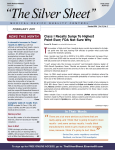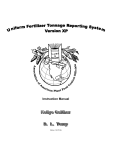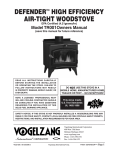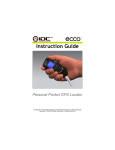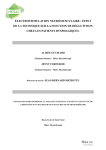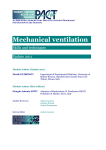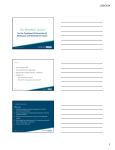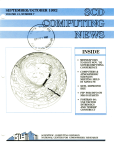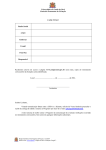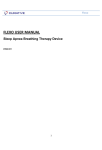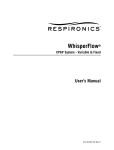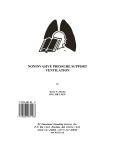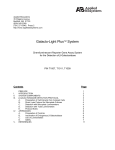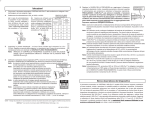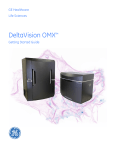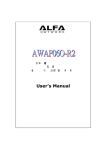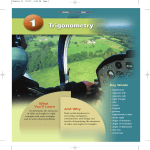Download LSC: Kingwood Undergraduate Research in Respiratory Care, vol 2
Transcript
1 Table of contents Editor’s comments…………………………………………………………………..3 Airway Clearance: The Effectiveness of the MetaNeb© using Two Cadaver Cow Lungs. Jovanna Mejia, SRT, Anna Dunahoe, SRT, Joyce Bukut, SRT, Jennifer McMurtrey, SRT, Shaun Jones, SRT……………………………………………………………………………………………………..4 Addendum to airway clearance…………………………………………………………….……….11 Bench Study: Comparison of Cuff Management Techniques in the Prevention of Ventilator Associated Pneumonia Darshane L. Miller SRT, April Anderson BS SRT, Ray Managbanag BS SRT, and Frederick Johnson BS LCCA SRT…………………………………………………………………………………………………..16 Bench Study: Time Needed for Cuff Pressure Stabilization At Body Temperature After Intubation Kimberly Gonzalez, L.V.N., S.R.T., Ana Vela, S.R.T., Juanita Robinson, S.R.T, and Stella Ekewenu, S.R.T…………………………………………………………………………………………25 Waveform Comparisons: The MetaNeb® and Vortran™ Jennifer Hua SRT, Kim Frie SRT, Cynthia Young SRT, Julissa Webb SRT………………………………………………………………………………………………………31 LSC: Kingwood College Journal of Undergraduate Research in Respiratory Care Vol 2 no 2 page 2 Editor-in-chief comments One of the ongoing requirements of LSC: Kingwood Associate in Applied Science Degree includes participation in the creation of this magazine for RSPT 2243 Research in Respiratory Care. Students formed teams that designed research projects for application during the semester. Some of the requirements of this course were membership in a weekly journal club of current articles from AARC’s Journal of Respiratory Care as well as active participation in writing the four papers in our journal based on their independent research. Students were also expected to provide peer-review of other teams’ papers. The summer 2012 editing board consisted of the following: Jovanna Mejia, S.R.T., Anna Dunahoe, S.R.T., Joyce Bukut, SRT, Jennifer McMurtrey, SRT, Shaun Jones, SRT Darshane L. Miller SRT, April Anderson B.S., S.R.T., Ray Managbanag B.S., S.R.T., Frederick Johnson B.S. L.C.C.A. S.R.T., Kimberly Gonzalez, L.V.N., S.R.T., Ana Vela, S.R.T., Juanita Robinson, S.R.T, and Stella Ekewenu, S.R.T., Jennifer Hua S.R.T., Kim Frie S.R.T., Cynthia Young S.R.T., and Julissa Webb S.R.T. All research this semester was in the form of bench studies. Half the class concentrated on exploring the MetanebTM IPV machine our program acquired this year. One team collected flow, volume and pressure graphics on the MetanebTM in various modes then compared these graphs to those created by the Vortran TM IPV machine. Another group filled a cadaver cow lung with artificial secretions then attached the MetanebTM in an attempt to mobilize secretions. The other foci of LSC: Kingwood College Respiratory Care Department’s investigation included bench studies of endotracheal tubes. One team measured the time it took for cuff pressures to stabilize at body temperature, while another team compared various methods of endotracheal cuff inflation and their ability to prevent material from above the cuff to contaminate the lower airways in a cadaver cow trachea. This year found several Kingwood College respiratory care research teams using cadaver cow lung donated by a local meat processing plant. Due to the extremely large trachea of the cows and the not quite human anatomy of these lungs, the team had their work cut out for them just finding a central airway that would fit the human-sized endotracheal tubes. The first team to dissect their cow lungs forged the trail for the rest of the teams. Isolating appropriate airways and working with fresh tissue that has not been preserved was more time-consuming than anyone expected. The program facilitator learned that kitchen shears are not only faster than scalpels on lung tissue, but safer. Although the tissue was from cattle deemed safe for human consumption, great efforts were taken to utilize personal protective gear and dispose of the material after. This was to my mind, one of the most frustrating and yet most enjoyable research classes I’ve ever conducted. We would like to take this occasion to thank Maribeth Stitt RDH Med. program director of the LSC: Kingwood College dental hygiene department who x-rayed the lungs. We thank the Garza Meat Processing Plant for donation of the cow lungs. Once again, LSC: Kingwood’s Graphic department lead by Shawn Sedoff provided a talented student-graphic designer via their annual Design-A-Thon. The student-graphic designer, Dominic Zotti, managed (in spite of my rather contradictory instructions) to design two wonderful covers for both 2012 volumes based on airway morphology and electron microscope views of the alveoli. As always, we thank Kenny McCowen program director for his foresight in creating the course and his continued support of this Associate degree research class as it moves closer to a second decade of existence. Elizabeth Kelley Buzbee A.A.S., R.R.T.- N.P.S., R.C.P. LSC: Kingwood College Journal of Undergraduate Research in Respiratory Care Vol 2 no 2 page 3 Airway Clearance: The Effectiveness of the MetaNeb© using Two Cadaver Cow Lungs. Jovanna Mejia, SRT, Anna Dunahoe, SRT, Joyce Bukut, SRT, Jennifer McMurtrey, SRT, Shaun Jones, SRT Faculty facilitator: Elizabeth Kelley Buzbee A.A.S., R.R.T.-N.P.S., R.C.P. Abstract INTRODUCTION: The MetaNeb© a version of intrapulmonary percussion ventilation is designed to increase the mucociliary clearance, improve gas exchange, humidify the airway, stabilize airway patency, and improve the lung mechanics. OBJECTIVE: To mobilize secretions from all lobes of the lungs with the use of the MetaNeb© machine. METHODS: Artificial secretions were verified for mobility in both trials. Conducted two trials; one cow cadaver lung was intubated and placed on Bilevel Positive airway Pressure mode and 30cc of synthetic secretions was instilled followed by positive pressure to send secretions into the lung. The lung was x-rayed. After 15 minutes on MetaNeb© at manufacturer’s recommended treatment settings, secretions were suctioned into sputum trap and the lung was x-rayed. The other lung was placed on Continuous Positive airway Pressure mode and metal shavings were added to the secretion. Lung was x-rayed. After 15 minutes on MetaNeb©, secretions were suctioned and x-ray repeated. Volumes and weights of secretions obtained with both methods were recorded. RESULTS: 3.21grams of secretions were removed from the lung on bi-level positive airway pressure; 1.45 grams were removed on continuous positive airway pressure. CONCLUSION: Significantly more secretions were removed from the lung during bi- level positive airway pressure than from continuous positive airway pressure. The total amount of secretions instilled was not recovered possibly due to the evaporation or absorption of the synthetic secretions into the lung tissue. Background The MetaNeb© was a version of intrapulmonary percussive ventilation (IPV). The first form of IPV, the Percussionaire TM, was introduced in 1979 by Dr. Forrest Bird (Cairo & Pilbeam, 2010). According to the manufacturer, the MetaNeb© system was originally designed to increase the mucociliary clearance, improve the gas exchange, humidify the airway, stabilize airway patency, and improve the lung mechanics (Reychler, et al., 2004). Theoretically, the advantage of IPV had “been described as a 2-fold effect in airway clearance” (Myers, 2007); the percussive motion or oscillations reportedly decreased the viscoelastic properties of the mucus and increased expiratory airflow, thus making it easier to mobilize secretions up and through the airways by means of short bursts airflow (Myers, 2007). The MetaNeb© is meant to be utilized in three different ways including lung expansion therapy, airway clearance, and aerosolized medication delivery. For the purpose of this research, lung hyperinflation is defined as increasing lung volume by increasing the transpulmonary pressure gradient (Wilkins, Stoller, & Kacmarek, 2009). Through a sliding Venturi with added continuous aerosol generation, the MetaNeb© device delivers rapid minibursts of gas mixture at 200 to 300 cycles per minute (Natale, Pfeifle, & Homnick, 1994). The technique of lung expansion was used to help mobilize and remove excessive bronchial secretions, help with lung expansion, and improve oxygenation (Berney & Denehyl, 2002). Medication aerosolized through an intrapulmonary percussive device results in a smaller particle size of 0.2 micrometers with an increased tidal volume and decreased respiratory rate causing greater deposition of the medication in the lungs when compared to small volume nebulizers of 1.89 micrometers (Reychler, et al., 2004). The background research used in this study was based on previous research of similar IPV systems, because there was limited resources on the MetaNeb© system. This investigation was designed to test the MetaNeb©’s ability to mobilize secretions in deceased animal lungs, thus answering the question: Can the MetaNeb© effectively mobilize secretions? The expectations are that the MetaNeb©, when applied with proper technique at recommended settings, will effectively mobilize secretions in all lung regions. For the purpose of the study two calf lungs were utilized. Both animal lungs were received within 12 hours of death and placed on ice for 72 hours. Inclusion criteria contained that the lungs were appropriately sized for intubation, fully intact, and the lungs could be harvested from pig, calf, or LSC: Kingwood College Journal of Undergraduate Research in Respiratory Care Vol 2 no 2 page 4 goat, also in addition, the lungs needed to be obtained or donated within 12 hours of death. Exclusion criteria included anything not the size of a pig, calf, or goat, past 12 hours of death and not intact. The animal lungs were thoroughly cleaned inside and out with water and soap prior to starting the experiment. The excess tissue, which would not harm the integrity of the lung, was cut away. The lungs were then kept flat on a cardboard box covered in plastic. The universal precautions were used, which included the standard gloves, gown, goggles, and mask. After the experiment, the lungs were discarded in the proper manner; wrapped, sealed, and double-bagged in an industrial grade garbage bag. The equipment that was used is stated in the addendum. All equipment was calibrated prior to starting the experiment. For this study the utilization of the resources available on campus were used, which for this case instead of a chest x-ray a dental xray unit ultra oral number three size film Kodak's speed D was used. The MetaNeb© was calibrated by performing the Function Test according to the manufacture’s manual. Because of the added bacteria filter to the circuit, which is not mentioned in the manufacture’s recommendations, a waveform test was performed showing the difference between the manufacture’s recommendations versus the circuit with the added bacteria filter; the waveform findings showed no major changes between the two tests. Equipment Calibration Scale Calibration 1. Power on the balance 2. Press calibration button and obtain calibration number after pressing "Cal" button 3. Power off and restart the balance 4. Place calibration weights located on the side of the machine 5. Allow time to calibrate 6. Confirm 200g Perform Viscosity Test For the viscosity test, the foam poster board was marked in centimeters to determine the length of the board. This particular board was 51 centimeters long. The board was then propped on top of a table with an incline of 30o and a 2x6 clear plastic wrap was placed at the bottom of the board to catch the secretions. A batch of synthetic secretions was mixed and 5cc of the secretions were drawn up in a 30cc syringe. At the top of the board, the secretions were slowly released from the syringe and the stopwatch was started at the same time. The trial was repeated once more, to get two trial runs for each lung. MetaNeb© Calibration Preparation of Secretions The synthetic secretions were prepared using six tablespoons of lime gelatin mix which was mixed with one cup of boiling water, left to return to room temperature, and stirred occasionally with a fork. One cup of corn syrup was then added, stirred gently with the fork, and the mixture was put in a freezer for 30 minutes. The mixture was removed from the freezer, stirred with a fork, and left sitting at room temperature for an additional 30 minutes. Two tablespoons of warm water was added and mixed in with a fork before each test to restore the original viscosity. Protocol of experiment Step 1. the lungs were modified by cutting away any excess tissue in order to find an appropriately sized airway to use an endotracheal tube size 8. Step 2. animal lung was set flat on cardboard that was wrapped in plastic. Both of the test subjects were intubated in a lobe with a smaller airway that could support the size of the endotracheal tube; the cuff was inflated to maintain a good seal. Step 3. the endotracheal tube was then attached to a Portex self inflating manual resuscitator bag and the lungs were then manually bagged. This was done to recruit alveoli. Step 4. the lungs were then connected to a Respironics V60 Ventilator to apply BiPAP/CPAP and maintained the inflation of lung. Step 5. perform viscosity test for secretions. (Refer to How to Perform Viscosity Test subheading.) Step 6. the M-PROVE top-loading balance scale was zeroed, the empty syringe, and empty sputum trap were weighed. This was done to adjust for the weight of the containers in the results. Step 7. the synthetic secretions were weighed in the syringe. Step 8. then 30cc of synthetic secretions was administered into the airway via syringe. Step 9. the lung was placed back on BiPAP and the secretions were manually massaged into the distal airways. LSC: Kingwood College Journal of Undergraduate Research in Respiratory Care Vol 2 no 2 page 5 Step 10. The BiPAP settings were set at: Ipap 40cmH2O/Epap 12cmH2O, respiratory rate 20 breaths per minute. Step 11. the lung was transported to obtain pretreatment x-rays. This was done in order to see the density of the secretions for the purpose of the post-treatment comparison. Step 12. researchers then switched from the BiPAP setting to CPAP setting 40cmH 2O. This kept the lungs inflated and stationary during the x-ray. Step 13. x-ray of the lung was done. Three different density films were used for the x-ray; this was done in order to obtain which density gave the better observation of the secretions. Step 14. researchers resumed BiPAP and transported the lung back to the respiratory department. Step 15.lungs were then connected to the MetaNeb© at the standard setting for a treatment. Times on the MetaNeb© were according to the manufacture manual. The 15 minute treatment shifted between lung expansion CPEP (Continuous Positive Expiratory Pressure) for 2 ½ minutes and then airway clearance CHFO (Continuous High Frequency Oscillation) for 2 ½ minutes until 15 minutes was reached. While against the manufacture’s settings, the cuff was kept inflated so inflation was not lost. Step 16. promptly after the treatment, the lung was suctioned twice with a suction catheter inserted 2 cm past the ET tube, 5ml normal saline was administered, and a -120mmHg suction pressure was applied. Step 17. all synthetic secretions acquired from suctioning was collected in a sputum trap connected to the in-line suction catheter. Step 18. the synthetic secretions were measured in volume using milliliters (cc) and weighed with the scale. Step 19. repeat steps 10 - 13 for post-treatment assessment. Step 20. post x-ray of the same area of the lung was performed after secretions were removed. Step 21. findings were evaluated. The same procedure was repeated with the other lung, except this lung was kept on CPAP as the secretions were being inserted, and metal aluminum pieces were inserted. All equipment was kept clean between each experiment per manufacturer’s instructions. The setup used for the procedure: ET-tube, in-line suction catheter, sputum trap, suction tubing, bacteria filter, Tpiece/adapter, MetaNeb©, corrugated tubing, BiPAP/CPAP Results Trial One Viscosity test A viscosity test was performed on lung one to show that the secretions were mobile. Two trials were performed using 5mL of secretion that traveled 51 centimeters (cm); the mean time for both trials was 12.45 seconds (SD .49 sec). The test was measured in cm per second, to demonstrate how fast the secretions moved. For the calculation of speed at which the secretions traveled the equation, distance divided by time was utilized. The mean speed was 4.09 cm/second (SD 0.163 cm/sec). Table 1 LSC: Kingwood College Journal of Undergraduate Research in Respiratory Care Vol 2 no 2 page 6 Initial settings: BiPAP EPAP 12 cmH2O 40 cmH2O IPAP 20 RR 21 % FIO2 157 mL Vt 40 cmH2O PIP Table 1 illustrates the initial settings used when the lung was placed on BiPAP. Table 2 Ventilator parameters during treatment: Airway Clearance (CHFO) & Lung Expansion (CPEP) Parameters CHFO CPEP 12 cmH O 12 cmH EPAP 2 2O 36 cmH2O 36 cmH2O IPAP 20 bpm 20 bpm Respiratory Rate 21 % 21 % FIO2 1193 mL 1218 mL Vt 36 cmH2O N/A PIP 23.9 L/min 24.4 L/min Ve Table 2 shows the ventilator setting during the treatment, while the lung was attached to the MetNeb© during CHFO and CPEP. The ventilator setting during the treatment was attached to the MetNeb© (CPEP), which was set on lung expansion. Figure 1 X-rays Lung One: Pretreatment X-Ray Trial Two Viscosity test A viscosity test was performed on lung two to show that the secretions were mobile and constant. Two trials were performed using 5mL of secretion that traveled 51cm; the mean time for both trials was 11.40 seconds (SD .70 sec). The test was measured Post-treatment X-Ray meter per second, to demonstrate how fast the secretions moved. Speed was derived from the equation; distance divided by time. The mean speed was 4.48cm/second (SD 0.278 cm/sec). Table 3 LSC: Kingwood College Journal of Undergraduate Research in Respiratory Care Vol 2 no 2 page 7 Initial setting: CPAP CPAP 25 cmH2O 17 L/min Patient Leak 0 Respiratory Rate 21 % FIO2 18 mL Vt 25 cmH2O PIP 17% Ti/TToT 0 L/min Ve Table 3 illustrates the initial settings used when the lung was placed on CPAP. Table 4 Ventilator parameters during treatment: Airway Clearance CHFO & Lung Expansion CPEP Parameters CHFO CPEP 25 cmH2O 25 cmH2O CPAP 17 L/min 17 L/min Patient Leak 0 bpm 0 bpm Respiratory Rate 21 % 21 % FIO2 3387 mL 3387 mL Vt 43 cmH2O 43 cmH2O PIP 1.1 L/min 24.4 L/min Ve Table 4 shows, the ventilator setting during the treatment, while the lung was attached to the MetNeb© while on CHFO and CPEP. Figure 2 X-ray Lung Two: Pretreatment X-Ray Post-treatment X-Ray LSC: Kingwood College Journal of Undergraduate Research in Respiratory Care Vol 2 no 2 page 8 Figure 3 Secretions 3.5 3 2.5 2 1.5 1 0.5 0 Secretions Secretions removed Secretions removed on BiPaP (g) on CPaP (g) Figure 3 demonstrates the amount of secretions that was removed while on BiPAP (3.21grams) and CPAP (1.45grams), after the 15 minute treatment on MetaNeb©. While suctioning out the secretion, 5mL of normal saline was added to dilute the secretions. Figure 4 Percent change between trial one and two Secretions suctioned: Negative precent change 1. BiPaP 2 Secretions suctioned: Negative precent change 1 -100 -95 -90 -85 This figure compared secretions removal at different settings. The equation was derived from post-value subtracted from pre-value divided by pre-value times 100. The post-value was the amount of secretions after suction, and pre-value was the amount of secretion that was inserted into the lung. Discussion and Conclusion In using manufacturer recommended technique and settings, the researchers believed the MetaNeb© would effectively mobilize secretions in all lung regions. When performing the experiment, there were some limitations and other factors that should be further investigated to perhaps improve patient care. The results of the trials did not support the hypothesis due to unexpected limitations, however many questions arose that should be further investigated. Trial One Trial one was performed with 37.46 grams of synthetic secretions with an average viscosity of 4.09cm/sec. The lung was ventilated using the BiPAP mode for the duration of trial; using settings that would maintain inflation (see Table 1). BiPAP was also used throughout the duration of the MetaNeb© treatment which was performed according to manufacturer’s specifications (see Table 2). Treatment was administering for 15 minutes, and then the lung was suctioned and returned 3.21 grams of synthetic secretions after instilling 5mL of normal saline (see Figure 3). Trial Two Trial two was performed by instilling 38.35 grams of synthetic secretions with an average LSC: Kingwood College Journal of Undergraduate Research in Respiratory Care Vol 2 no 2 page 9 viscosity of 4.48 cm/sec. The lung was ventilated with CPAP throughout the trial with settings that achieved lung inflation (see Table 4), and was also used during the MetaNeb© treatment. The parameters of the ventilator during the MetaNeb© treatment can be found in Table 5. After the 15 minute MetaNeb© treatment the lung was suctioned and 1.45 grams of synthetic secretions were retrieved (see Figure 3). Comparison between Trial One and Trial Two These trials were designed to show the effectiveness of the treatment but proved inconclusive most likely because of some major limitations and other factors. The time allotted to conduct these trials limited the research to only two trials instead of the ideal three trials. Also the two trials that were performed were using two different modes of ventilation. These two trials returned different amounts of secretions Figure 4 shows the two trials compared in percentage. The researchers found it interesting that BiPAP returned more secretions than CPAP mode. This requires further investigated. During the first trial it was believed that BiPAP was necessary to maintain cadaver lung inflation, however during the second trial it was discovered that CPAP could be used to maintain the same inflation if lung recruitment maneuver was performed prior to placing lungs on CPAP. The xrays taken during the two trials did not indicate any change in secretions; however the x-ray was taken with dental equipment which limited to clarity and quality. Another factor that may have affected the trials is evaporation or absorption of the synthetic secretions into the lung tissue; researchers believed that the absorption or evaporation could have been changed by heating and humidifying the ventilator circuit. Due to the fact that the lung being used was not a viable lung, there was no cilia activity and muscle action which caused may have limited clearance of the airways. The lung was not at body temperature it possibly affected the delivered volumes. When ventilating the lung, positive pressure was used instead of negative pressure to allow the lung to stay inflated when examining under x-ray. This allowed the lung to dry out causing the secretions that were inserted in the lung to be absorbed and/or evaporated. The purpose of the MetaNeb© is to mobilize the secretions from the upper airways, the cow lung trachea was too large for a human endotracheal tube therefore smaller airways were intubated in both trials; the MetaNeb© is made to mobilize secretions in the central airways and the area distal to the endotracheal tube that was placed was more peripheral than if the cow lung had been intubated in the tracheal. Conclusion The MetaNeb© is still a new product that may be an effective means of mobilizing secretions, but there is little literature about it and it should be further studied to assess the effectiveness. The researchers believed that the MetaNeb© would mobilize secretions from all lung regions but the results of these trials do not support this hypothesis. Researchers were surprised by the minimal amount of secretions that were returned leading the researchers to believe that the trials were hindered by possible evaporation and absorption of the synthetic secretions; it would be interesting to study this further. Other possible research stemming from questions that arose in these trials is to study the possible effect that heating and humidifying the ventilator circuit would have on secretion mobilization in patients with secretion buildup. Limitations References Berney, S., & Denehyl, L. (2002). A comparison of the effects of manual and ventilator hyperinflation on static lung compliance and sputum production in intubated and ventilated intensive care patients. Physiotherapy Research International, 100-108. Retrieved from http://www.ncbi.nlm.nih.gov/pubmed/12109234 Cairo, J. M., & Pilbeam, S. P. (2010). Mosby's Respiratory Care Equipment. St. Louis, Missouri: Mosby Elsevier. Comedica Incoperated. (n.d.). MetaNeb. Retrieved June 18, 2012, from MetaNeb System: http://www.metaneb.com/ Myers, T. R. (2007, October). Positive Expiratory Pressure and Oscillatory Positive Expiratory Pressure Therapies. Respiratory Care, 52(10), 1308-1327. Retrieved from http://www.ingentaconnect.com/content/jrcc/rc/2007/00000052/00000010/art00002 Natale, J. E., Pfeifle, J., & Homnick, D. N. (1994, June). Comparison of intrapulmonary percussive ventilation and chest physiotherapy: a pilot study in patients with cystic fibrosis. CHEST, 105(6), 1789-1793. LSC: Kingwood College Journal of Undergraduate Research in Respiratory Care Vol 2 no 2 page 10 Reychler, G., Keyeux, A., Cremers, C., Veriter, C., Rodenstein, O. D., & Liistro, G. (2004). Comparison of Lung Deposition in Two Types of Nebulization: Intrapulmonary Percussive Ventilation vs Jet Nebulization. CHEST, 125(2), 502-508. Vienne, M., Dziri-Richez, C., Bensalah Tolba, F., Vaillant-Ettaiche, M., Navarre, P., & Bougatef, A. (2009, March). Forrest Morton Bird : quand l’aviation me`ne. Journal de re´adaptation me´dicale, 29(1), 25-34. Wilkins, R. L., Stoller, J. K., & Kacmarek, R. M. (2009). Egan's Fundamentals of Respiratory Care (9th ed.). St. Louis, Missouri: Mosby Elsevier. Addendum 1. Outfit in gown, glove, mask and goggles 2. Clean, cut lung, find airway to intubate 3. At same time perform function test for the MetaNeb© LSC: Kingwood College Journal of Undergraduate Research in Respiratory Care Vol 2 no 2 page 11 Waveforms to check for effect of bacterial filter MetaNeb© by itself MetaNeb© with bacteria filter Calibrate scale – then weigh syringe & trap to zero out Viscosity test with synthetic secretions LSC: Kingwood College Journal of Undergraduate Research in Respiratory Care Vol 2 no 2 page 12 Prepare lungs - place on cardboard Intubate lung lobe instillation of mock secretion alveolar recruitment Place Lung on BiPAP/CPAP LSC: Kingwood College Journal of Undergraduate Research in Respiratory Care Vol 2 no 2 page 13 Transport to dental hygiene Pretreatment X-ray treatment with MetaNeb© (15 min.) Suction afterwards Added normal saline and massaged into lower lung to mimic forceful cough. Post-treatment X-ray LSC: Kingwood College Journal of Undergraduate Research in Respiratory Care Vol 2 no 2 page 14 Personal Protective Equipment Hospital grade gown, glove, mask and goggles Kitchen shears MetaNeb© Manufacturer Hil-Rom Address From Manufacturer: Singapore (Equipment made in USA) serial # 10-01911 item # C20130 Standard MetaNeb© circuit Self Inflating Manual Resuscitator Portex BiPAP/CPAP Manufacturer Phillips Brand name: Respironics Model: V60 Manufacture address: Respironics CA Inc. 2271 Cosmos Court, Carlsbad, CA 92011 Waveform machine Manufacturer HANS RUDOLPH, Inc Series 1101 Breathing Simulator Address from Manufacturer: 7200 Wyandotte, Kansas City, Missouri 64114 USA Xray machine Attached to the Wall Intraoral Xray unit By: Sirona Model No.: 4684606-D3302 Serial No.: 23652 Manufactured: 2003 Arm piece – exposure tube Model No.: 4681263 Serial No: 31820 Scale Company name: Santorius Model Name: M-prove Serial No: 27355093 Stock No: 3 Syringe 30cc, 12cc, 3cc Suction Connector Tubing 72 in length with 3/16 diameter made in Mundelein, IL, lot # 9905081 Date 2004/05 reorder # DYND50216 Endotracheal Tube Size ID (Inner Diameter) 8.0 Cuff Diameter: 27.5mm Tube OD (Outer Diameter) MM 9.3mm Reference: 112082070 Serial Number: (01)04026704300402 Lot No. 08LE49 Made by: Teleflex Address: Research Triangle Park, NC. Inline suction catheter Closed suction system for adults (AKA Inline suction) Size: 14 French Length: 54cm Reference: 2205 Manufactured by: Ballard Medical Products – Draper, UT Distributed by: Kimberly-Clark Global Sales Inc. – Roswell, GA Bacterial Filter Guardian (Disposable Bacterial/Viral Filter) Record #FH 603003 22mm OD/15 mm ID x 22mm ID/15 mm OD Manufactured By: Ventlab Corporation 155 Boyce Drive Mocksville, HC 27028 Lot: 02452 Sputum trap Sherwood medical Address given: St. Louis, MO. 63103 USA Assembled in Mexico. Re-Order No.: 8884-724500 074-0490 40cc (or ml) LSC: Kingwood College Journal of Undergraduate Research in Respiratory Care Vol 2 no 2 page 15 Bench Study: Comparison of Cuff Management Techniques in the Prevention of Ventilator Associated Pneumonia Darshane L. Miller SRT, April Anderson BS SRT, Ray Managbanag BS SRT, and Frederick Johnson BS LCCA SRT Abstract PURPOSE: This research compared current cuff management techniques to determine which was most effective in the prevention of ventilator associated pneumonia. OBJECTIVE: To determine if using a manometer will prevent the most amount of simulated oronphrynegeal secretions from falling below the cuff of a well lubricated ET tube. METHODS: Each cuff management technique was performed once using 8.5 mm and 9.0 mm lubricated endotracheal tubes inserted into the tracheae of cow cadavers. Dyed egg white solution was placed above the cuff. A tracheal lavage was performed after three minutes of manual ventilation to determine the amount of dyed egg white solution that fell below the cuff after ventilation. RESULTS: Based on volume, weight, and color changes, the trial using a manometer to manage cuff pressure was the most effective technique in preventing simulated secretions from falling below the cuff during ventilation. The minimal leak technique was determined to be the least effective cuff management technique. CONCLUSION: Using a manometer to manage cuff pressure prevented the most simulated secretions from falling below the cuff of a well lubricated ET tube during ventilation. Keywords: manometer; minimal leak technique; minimal occluding volume; ventilator associated pneumonia; lubrication; cuff pressure. Background When a patient is unable to maintain or risk of ventilator associated pneumonia (VAP) is protect the upper airway mechanical ventilation is greatest during the first five days of intubation but often required. The initial airway used for can occur at any time during the intubation period. mechanical ventilation is an appropriately sized Bacteria contaminated secretions from the endotracheal (ET) tube which consists of a 15-mm oropharynx slide down the longitudinal folds of the adapter, polyvinyl chloride (PVC) tube, permanently inflated cuff, created when the cuff pushes against the bonded cuff, small filling tube, and a pilot balloon wall of the trachea, into the lower airway (Blunt, (Wilkins, Stoller, & Kacmarek, Fundamentals of Young, Patil, & Haddock, 2001). Once in the lower Respiratory Care, 2009). The purpose of the cuff is airway, the bacteria colonize and signs and symptoms to prevent the transfer of secretions from the upper of ventilator associated pneumonia (VAP) begin to airway into the lower airway and to allow positive present. pressure ventilation to be administered to the patient. Current strategies used to prevent ventilator Cuff status and pressure are managed and adjusted associated pneumonia (VAP) include hand washing, using the pilot balloon. Artificial airway cuff routine suctioning and oral care, patient isolation, pressure is recommended to be within the range of 20 patient positioning, lubrication of the endotracheal – 30 centimeters of water (cm H2O) (Howard, 2011). (ET) tube cuff with a water-based gel, and Higher cuff pressures can cause damage to the maintaining endotracheal (ET) tube cuff pressure tracheal tissue such as necrosis, stenosis, or above 20 centimeters of water (cm H 2O) to prevent tracheomalacia. Lower cuff pressures can cause oropharyngeal secretions from falling below the cuff. secretions from the oral cavity and upper airway to Methods used to manage cuff pressure migrate below the cuff into the lower airway. This is include attaching a calibrated manometer, performing the leading contributor to ventilator associated the minimal occluding volume technique, and pneumonia (VAP) (Wilkins, Stoller, & Kacmarek, performing the minimal leak technique. The 2009). technique of using a manometer to manage cuff Ventilator associated pneumonia (VAP) pressure involves inserting a calibrated manometer accounts for 80-90% of nosocomial pneumonias in into the spring loaded end of the pilot balloon. The intensive care unit (ICU) patients (Deem & Treggiari, pressure inside of the cuff is displayed on the screen 2010). It prolongs the length of hospital stay, and air can be added or withdrawn to maintain a cuff increases healthcare costs, and increases the risk of pressure of 20-30 centimeters of water (cm H2O). death within the critically ill adult population The minimal occluding volume technique involves (O'Keefe-McCarthy, Santiago, & Lau, 2008). The completely deflating the cuff with a 10 milliliter LSC: Kingwood College Journal of Undergraduate Research in Respiratory Care Vol 2 no 2 page 16 (mL) syringe attached to the pilot balloon until airflow is heard around the cuff during a positive pressure breath. Once airflow is heard, the cuff is slowly inflated until airflow is no longer heard. The minimal leak technique is performed the same way as the minimal occluding volume technique; however a small amount of air is removed once no airflow is heard around the cuff (Wilkins, Stoller, & Kacmarek, 2009). Our research will compare the ability of the above cuff pressure management techniques to prevent leakage of oropharyngeal secretions below the cuff of an endotracheal (ET) tube placed inside the trachea of an animal cadaver. Our research will also explore the role cuff lubrication plays in preventing upper airway secretions from entering into the lower airway. It is expected that using a manometer will be the most effective method of cuff management and that lubricating the cuff will play a key role in preventing VAP. Methodology Materials To test the effectiveness of the three cuff management techniques on lubricated endotracheal (ET) tube cuffs, the following materials were used: 1. 22 inch x 28 inch White Poster Board for Testing of Egg Whites Viscosity 2. CPE Plastic Isolation Gowns (disposable) Manufactured by: Wuhan Vanjoin Light Industrial Products Co., Ltd - Hubei, China 3. Dynarex Ear Loop Procedure Mask w/Splash Face Visor (disposable) Manufactured by: Dynarex Corporation - 10 Glenshaw Street, Orangeburg, NY 10962 4. Defender Examination Gloves (disposable) Manufactured by: Digitcare Corp. - 2999 Overland Ave., Los Angeles, CA 90064 5. Staples® Economy Rubber Bands Size #18 6. Cow Tracheae and Lungs Donated by Garza Processing Market - 4519 Theiss Rd # 1Humble, TX 77338 7. Disposable Surgical Scalpel Manufactured by: Med Pro Corporation Shandong, China 8. Ultra Concentrated Dawn Dishwashing Liquid Detergent Size: 709 milliliter (mL) bottle Distributed by: Procter & Gamble – Cincinnati, OH 45202 9. Napkins 10. Scotch® Packing Tape Premium Heavy Duty 3770RD. Clear Size: 1.88 inches x 54.6 yards 11. Velcro® Sticky BackTM Hook & Loop Fastener General Purpose Tape, Black Size: ¾ inch (in.) x 15 feet (ft.) Roll 12. Wooden Yard Stick 13. Makeshift Aluminum Foil-Covered 45° Angle Cardboard Ramp 14. Craftsman 12-inch Stainless Combination Square 15. PDI Sterile Lubricating Jelly Size: 5.0 grams (g.)/0.17 ounce (oz.) packets Manufactured by: Professional Disposables International, Inc. Orangeburg, NY 10962 16. Parker Flex-Tip PFHV (High Volume Low Pressure Cuff) Tracheal Tube-Cuffed Size: 8.5 millimeter (mm) and 9.0 millimeter (mm) Cat no.: 86453 Lot no.: 090300-0686 Date: 2010/05 Manufactured by: Well Lead Medical Guangzhou, China Manufactured for: Parker Medical 7275 S. Revere Pkwy. Suite 804, Englewood, CO 80112 17. 10-milliliter (mL) Disposable Syringes Model: 10mL Luer Lock Tip Lot no.: 070823 Manufactured by: Exelint International Co. 5840 W Centinela Ave. Los Angeles, CA 90045 18. Posey Cufflator Endotracheal Tube Inflator and Manometer Manufactured by: J.T. Posey Company 5635 Peck Road, Arcadia, CA 91006-0020 19. Bag and Peep ValveAnesthesia Breathing Bag Lot no.: 97272-6494 Cat no.: N7905 Manufactured by: Owens-Brigam Medical Newland, NC Description: 0.5 Liter (L) hyperinflation set, hyperinflation elbow with plug, 84 inch (in.) star lumen tubing with connectors. 20. Precision Medical® Flowmeter, 0-15LPM Model 1MFA Manufactured by: Precision Medical® 300 Held Drive, Northhampton, PA 18067 21. MicroGard Microbial Filter Manufactured by CareFusion, 22745 Savi Ranch Pkwy., Yorba Linda, CA 92887 22. Crystal Farms AllWhites® 100% Liquid Egg Whites Size: 32 ounce (oz.) carton Manufactured by: Crystal Farms, a Michael Foods Company 23. Great ValueTM Green Food Color & Egg Dye 0.25 ounce (oz.) bottle Size: 0.25 ounce (oz.) bottle Distributed by Wal-Mart Stores, Inc., Bentonville, AR 72716-1100 24. 40-cubic centimeter (cc) specimen trap Re-Order No.: 8884-724500 Assembled in Mexico LSC: Kingwood College Journal of Undergraduate Research in Respiratory Care Vol 2 no 2 page 17 Manufactured for: Sherwood Medical, St. Louis, MO 63103 25. McGaw Sterile Water for Irrigation USP Size: 1000 milliliter (mL) Expiration Date 08/02 Lot no.: J9K187 Manufactured by: McGaw, Inc. Irvine, CA 927145895 26. Inline Suction Catheter Ballard® Adult Trach Care® T-Piece Size: 14 French/4.6 mm Length: 54cm Reference: 2205 Manufactured by: Ballard Medical Products – Draper, UT Distributed by: Kimberly-Clark Global Sales, Inc. – Roswell, GA 27. Medical Industries America, Inc. Portable Suction Machine 120 VAC/60 Hz. Serial No.: 55644 Manufactured by: Medical Industries America, Inc. 26378 289th Pl., Adel, IA 50003 28. Suction Connection Tubing Length: 72 inches (in.) Diameter: 3/16 inches (in.) Lot No.: 0501141 Date: 2010/01 Manufactured by: ConMed Corporation – 310 Broad St., Utica, NY 13501 29. Precision Weighing Scale Model: M-Prove Serial No: 27355093 Manufactured by: Sartorius AG - Weender Landstr. 94-108, 37075 Goettingen, Germany 30. Contractor’s Choice 42-Gallon Contractor Clean-up Bags Size: 42 gallon x 12 bag box Manufactured by: Poly-America, 2000 West Marshall Drive, Grand Prairie, Texas 75051 Egg whites were used to represent oropharyngeal secretions for this experiment and were colored using green food dye to increase visibility. Viscosity of the dyed egg white solution was tested by placing 2.5 milliliters (mL) of ambient room temperature solution on one end of a single vertical line drawn on a poster board. The vertical line was previously marked in one inch (in.) increments up to a total of 22 inches. The poster board was raised to a 45° angle to allow the solution to flow from top to bottom and traveled at a rate of 22 inches in 2.6 seconds. Due to the bio hazardous nature of the materials used, universal precautions were taken. Personal protective equipment worn during the experiment included: disposable barrier gowns, examination gloves, and surgical masks with face shields. Three cow tracheae were prepared by first removing the visceral pleura and cutting off the lungs two inches above the carina using a disposable surgical scalpel. The tracheae were then washed using regular dishwashing detergent and tap water. These were rinsed again to remove any detergent residue. The distal ends of each trachea were wrapped with paper napkins and taped to reduce diameter. Velcro ® Sticky BackTM Loop Fastener Tape was attached 3 inches from the end of each trachea. Prior to preparation, cow tracheae were removed from three calves and kept on ice in a large ice chest for less than 72 hours. A ramp was used to simulate a patient’s bed set at a 45 o angle. It was created by covering an illustration board with aluminum foil and taping it to a manila paper-covered large cardboard box. A 12-inch Stainless Combination Square was used to ensure the ramp was set at a 45 o angle. Four inch strips of Velcro® Sticky BackTM Hook Fastener Tape were placed 8 inches apart along the top of the ramp. LSC: Kingwood College Journal of Undergraduate Research in Respiratory Care Vol 2 no 2 page 18 The scale used for this experiment was not calibrated, but was zeroed prior to each use by clearing the base plate and pressing the “Zero” button located in the lower right hand corner. Statistics Microsoft® ExcelTM was used to compile data for this experiment. Tables were created using Microsoft ® WordTM. Procedure The following steps were taken to test Trial #1: Using a Manometer to Manage Cuff Pressure. Trial #1: 1. Attached disposable examination glove on the distal end of cow trachea with rubber band. 2. Secured cow trachea to ramp using Velcro® Sticky BackTM tape with proximal end pointing upward. 3. Liberally squeezed 1 packet of lubricating jelly onto the outside of the ET tube cuff. 4. Inserted lubricated ET tube into the distal end of the calf trachea up to the point where the edge of the trachea was between “Parker” and “Medical” on the ET tube (12 cm on 9.0 mm ET tube and 11.5 cm on 8.0 mm ET tube). 5. Secured ET tube to ramp using Velcro® Sticky BackTM tape. 6. Inflated cuff with a 10-milliliter (mL) disposable syringe until trachea expansion can be seen from the outside of the trachea. 7. Attached a manometer to the pilot balloon of the ET tube and adjusted cuff pressure to 120 centimeters of water (cm H2O) pressure. 8. Connected flow inflating anesthesia breathing bag to wall oxygen source and set flowmeter to 15 liters per minute (lpm). An antimicrobial filter was attached to the end of the resuscitation bag to protect equipment. 9. Anesthesia breathing bag was tested for leaks by placing a gloved hand over the open end of the antimicrobial filter and allowing the bag to inflate. After testing the bag, it and the filter were connected to the ET tube at the patient port. 10. Injected 2.5 milliliter (mL) of room temperature dyed egg white solution into trachea above the cuff using a 10milliliter (mL) disposable syringe. 11. Pumped anesthesia breathing bag at a rate of 20 times per minute to simulate breathing. 12. While manual ventilation took place, a specimen trap containing 10 milliliters (mL) of sterile water was weighed on a calibrated scale. The sterile water was then removed from the specimen trap using a 10 milliliter (mL) disposable syringe. The empty specimen trap was connected to an inline suction catheter and a portable suction device. 13. After three minutes of manual ventilation, the anesthesia breathing bag and filter were removed and the inline suction catheter was connected to the ET tube at the patient port. 14. The 10 milliliters (mL) of sterile water from step 12 was injected into the instillation port of the inline suction catheter. 15. Set suction device to -20 millimeters of mercury (mmHg) and passed entire length of suction catheter down ET tube three times. Remaining fluid in glove was extracted by puncturing/cutting off glove fingers and/or squeezing out the solution into the specimen trap. 16. The specimen trap with sterile water and dyed egg white solution was reweighed. Volume and color of solution were recorded. 17. Double bagged used cow trachea and ET tube for disposal. The following steps were taken to test Trial #2: Using Minimal Leak Technique to Manage Cuff Pressure. Trial # 2: 1. Repeated steps 1 through 5 of Trial # 1. LSC: Kingwood College Journal of Undergraduate Research in Respiratory Care Vol 2 no 2 page 19 2. 3. 4. 5. Attached flow inflating anesthesia breathing bag and antimicrobial filter to ET tube at patient port and manually ventilated at a rate of 20 breaths a minute. Slowly inflated cuff with a 10 milliliter (mL) disposable syringe until airflow heard escaping around the cuff during a positive-pressure breaths ceased. Once a seal was obtained, a small amount of air was removed, allowing a slight leak at peak inflation pressure. Connected flow inflating anesthesia breathing bag to wall oxygen source and set flowmeter to 4 liters per minute (lpm). An antimicrobial filter was attached to the end of the resuscitation bag to protect equipment. Repeated Steps 9 through 17 of Trial # 1. The following steps were taken to test Trial #3: Using Minimal Occluding Volume Technique to Manage Cuff Pressure. Trial # 3: 1. Repeated Steps 1 through 5 of Trial # 1. 2. Attached flow inflating resuscitation bag and antimicrobial filter to ET tube at patient port and manually ventilated at a rate of 20 breaths a minute. 3. Slowly inflated cuff with a 10 milliliter (mL) disposable syringe until airflow heard escaping around the cuff during a positive-pressure breaths ceased. 4. Connected flow inflating anesthesia breathing bag to wall oxygen source and set flowmeter to 4 liters per minute (lpm). An antimicrobial filter was attached to the end of the resuscitation bag to protect equipment. 5. Repeated Steps 9 through 17 of Trial # 1. Results Volume Table 1 lists all recorded volumes for each trial. Mean volume loss (n = 3) for all three trials was 0.667 mL (SD = 1). Trials #1 and #3 each had a volume loss of 1 mL sterile water solution after the tracheal lavage. Table 1 Recorded Volumes of Sterile Water Solution Before and After Tracheal Lavage Trial #1 MAN Trial #2 MLT Trial #3 MOV Volume of Instilled Water for Tracheal Lavage (mL) 10 10 10 Volume of Suctioned Water from Tracheal Lavage (mL) 9 10 9 Difference in Water Volume Before & After Tracheal Lavage (mL) -1 0 -1 Percent Change -10 0 -10 MAN = manometer, MLT = minimal leak technique, MOV = minimal occluding volume LSC: Kingwood College Journal of Undergraduate Research in Respiratory Care Vol 2 no 2 page 20 Weight Weight loss for all three trials ranged from 1.40 g to 2.03 g. Mean (n = 3) weight loss for all three trials was 1.73 g (SD = 0.316069613) with a median of -1.76 g. Trial #1 had the most weight loss with a 2.03 g difference from its pre-experiment weight. Trial #2 had the least amount of weight loss. See Table 2 for all recorded weights for each trial. Table 2 Trial #1 MAN Trial #2 MLT Trial #3 MOV Weight of Specimen Trap and Sterile Water Before Tracheal Lavage (g) 38.40 40.80 37.71 Weight of Specimen Trap and Sterile Water Solution After Tracheal Lavage (g) 36.37 39.40 35.95 Difference in Weight of Specimen Trap and Sterile Water or Solution Before & After Tracheal Lavage (g) -2.03 -1.40 -1.76 Percent Change -5.29 -3.43 -4.67 Weights of Specimen Trap and Sterile Water Solution Before and After Tracheal Lavage Visible Characteristics of Sterile Water Solution Figure 1 Sterile Water Solution After Tracheal Lavage for Trials 1-3 1 2 3 MAN MLT MOV LSC: Kingwood College Journal of Undergraduate Research in Respiratory Care Vol 2 no 2 page 21 Table 3 Descriptions of Sterile Water Solution after Tracheal Lavage Trial #1 MAN Cloudy but still translucent, Light pink, No visible bubbles/foam on surface Trial #2 MLT Cloudy, Opaque, Tan with Greenish Tint, Significant amount of visible bubbles/foam on surface Trial #3 MOV Cloudy and opaque, Pink, Slightly visible bubbles/foam on surface Discussion Categories used to determine the any additional volume was attributed to dyed egg effectiveness of each cuff management technique white solution that managed to fall below the cuff of were volume, weight, and visible characteristics of the ET tube. Weight loss post tracheal lavage was the sterile water solution after tracheal lavage. Data considerably less when compared to technique collected from the experiment supports the involving using a manometer. Dyed egg white hypothesis that using a manometer is the most solution that managed to fall below the cuff made up effective cuff management technique and prevents the difference in weight (0.63 g). Sterile water used the most amount of dyed egg white solution from for the lavage went from clear and translucent to leaking below the cuff of a well lubricated ET tube. cloudy, opaque and khaki colored. The trial that involved using a manometer to The minimal occluding volume technique manage cuff pressure (trial #1) had the least amount (trial #3) was seen to be less effective than using a of dyed egg white solution fall below the cuff during manometer, but more effective than the minimal leak positive pressure ventilation. This was demonstrated technique. This was demonstrated in only two of the in all three categories. One milliliter of sterile water three categories. The volume of sterile water lost solution was lost during the tracheal lavage. This during the lavage with this technique was the same as was the assumed baseline for each trial due to the volume lost using a manometer (1 mL). tracheal tissue absorption of the sterile water Though they were the same, it was assumed solution. This absorption also caused a decrease in that some dyed egg white solution did fall below the weight in all three trials. The manometer method had cuff based on the other categories. The weight loss the greatest weight loss of the three methods of sterile water solution after the lavage for this indicating no significant addition of dyed egg white technique was not as much as with using a solution to the sterile water for the lavage. Contents manometer but greater than using the minimal leak of the specimen trap after the lavage showed no technique. This along with the change in significant signs of dyed egg white solution. translucency and the presence of foam on the surface The minimal leak technique (trial #2) had of the solution in the specimen trap indicated that the most dyed egg white solution fall below the cuff some dyed egg white solution did fall below the cuff during ventilation and was demonstrated in all three of the ET tube. categories. The volume of the sterile water solution Research performed by Blunt et al, remained the same before and after the tracheal determined that water soluble lubrication on the cuff lavage. Assuming that about 1 mL of the 10 mL of an ET tube reduced the amount of oropharyngeal sterile water solution was absorbed by tracheal tissue, secretions from falling below the cuff during the first LSC: Kingwood College Journal of Undergraduate Research in Respiratory Care Vol 2 no 2 page 22 48 hours of intubation; a key timeframe in the prevention of VAP bacteria colonization (Blunt, Young, Patil, & Haddock, 2001). Lubricating the ET tube and using a manometer to manage cuff pressure should significantly reduce the incidence of VAP in a hospital setting when compared to other cuff management techniques. Limitations of this study Due to time constraints, each trial was performed only once. The research should be repeated with a minimum of three runs per trial to provide more conclusive results. Some volume of sterile water solution was lost due to absorption into dried tracheal tissue. It was assumed that this value is about 1 mL based on the results. A test run was not performed to determine how much sterile water solution would be lost and what factors affected the amount of solution lost. Another suggestion in correcting this requires the tracheae to be soaked in water until ready to use for the experiment. Also, the precision of the instrument used to measure volume was to the nearest whole number. Repeating the experiment with an instrument that measures to the thousandths would provide more accurate results especially when comparing using a manometer and minimal occluding volume. Despite manipulation of the tracheae, they were too big for the 8.5 mm and 9.0 mm tubes used for the experiment. This required cuff pressures to be higher than the normal 20 – 30 centimeters of water (cm H2O) range in order to ensure a good cuff seal against tracheal wall. Using a pressure of 120 cm H2O in a human would cause tracheal damage. Conclusion This research demonstrated that using a manometer to manage cuff pressure was the most effective technique in preventing oropharyngeal secretions from falling below the cuff of a well lubricated ET tube. The minimal leak technique had the most dyed egg white solution fall below the cuff and proved to be the least effective in the prevention of VAP. It is suggested that this technique be discontinued in patient care because more proficient methods are available. Future studies on this topic should explore how ineffective manometer cleaning in between patients affects the prevalence of VAP when compared to the other techniques using a disposable syringe. LSC: Kingwood College Journal of Undergraduate Research in Respiratory Care Vol 2 no 2 page 23 References Blunt, M. C., Young, P. J., Patil, A., & Haddock, A. (2001). Gel Lubrication of the Tracheal Tube Cuff Reduces Pulmonary Aspiration. Anesthesiology , 95 (2), 377-381. Deem, S., & Treggiari, M. M. (2010). New Endotracheal Tubes Designed to Prevent Ventilator-Associated Pneumonia: Do They Make a Difference? Respiratory Care , 55 (8), 1046-1055. Howard, W. R. (2011). Bench Study of a New Device to Display and Maintain Stable Artificial Airway Cuff Pressure. Respiratory Care , 56 (10), 1506-1513. O'Keefe-McCarthy, S., Santiago, C., & Lau, G. (2008). Ventilator-Associated Pneumonia Bundled Strategies: An Evidence-Based Practice. Worldviews on Evidence-Based Nursing , 193-204. Wilkins, R. L., Stoller, J. K., & Kacmarek, R. M. (2009). Fundamentals of Respiratory Care (Ninth ed.). (D. C. Shelledy, & L. Kester, Eds.) St. Louis, Missouri, USA: Mosby Elsevier. Bench Study: Time Needed for Cuff Pressure Stabilization At Body Temperature After Intubation Kimberly Gonzalez, L.V.N., S.R.T., Ana Vela, S.R.T., Juanita Robinson, S.R.T, and Stella Ekewenu, S.R.T Faculty facilitator: Elizabeth Kelley Buzbee A.A.S., R.R.T.-N.P.S., R.C.P. Abstract BACKGROUND: The purpose of this study is to determine the time it would take for cuff pressure to stabilize once the cuff is subjected to body temperature. OBJECTIVE: To determine how many minutes for the cuff pressures to increase after intubation. METHOD: Inflate size 7mm endotracheal tube and size 8mm endotracheal tube with 8 ml of air and place in 37 degree Celsius water bath. Check and record cuff pressure immediately, at 30 second intervals for 5 minutes. RESULTS: Immediately after submersion the size 7 endotracheal tubes cuff mean pressure ( n =3) was 24.0 cm H 20 ( SD 2.00) ; at 30 seconds the mean pressure was 32.67 cm H20 ( SD 3.05), at 150 seconds the mean pressure was 33.33 cm H 20 ( SD 3.05) , and at 300 seconds the mean pressure was 34.33 cm ( SD 3.51). Immediately after submersion the size 8 endotracheal tubes mean pressure ( n=3) was 22.67 cm H 20 ( SD 1.15) ; at 30 seconds the mean pressure was 24.67 cm H 20 ( SD 1.15); at 150 seconds the mean pressure was 26.67 cm H 20 ( SD 1.15); and at 300 seconds the mean was calculated to be 28.67 cm H20 ( SD 1.15). Conclusion: As this study was conducted it was shown that ETT cuff pressure took an average of three minutes to stabilize. Background Approximately 900 years have passed to be a cause of concern. Irreversible damage to the between the first intubation and the development of a tracheal mucosa can occur if the cuff pressure is too cuffed endotracheal tube (Bouvier, 1981). The high (Braz, Navarro, Takata, Nascimento, 1999). Arabian doctor Avicenna (980-1037) described the Undetected over-inflation of the endotracheal cuff first use of orotracheal intubation in dyspnea balloon may disrupt the capillary blood supply (Bouvier, 1981). The history of oral endotracheal leading to ischemia, inflammation, ulceration, intubation actually began in the 18th century. At that granulation, nerve and vocal damage, as well as, time obstetricians and lifesavers used breathing tubes stenosis at the site of contact between the cuff and (Bouvier, 1981). Regular oral intubation to keep the trachea (Braz et al., 1999). Endoscopic studies show respiratory tract clear during narcosis was first a correlation between elevated cuff pressures and applied by Franz Kuhn in 1900; unfortunately, the tracheal lesions (Braz et al., 1999). Post-operative pioneer himself did not live to see his method sore throat is also associated with elevated become a routine procedure. In 1928, Ralph M. endotracheal cuff pressure (Stewart, Secrest, Waters, M.D. and Arthur E. Guedel, M.D. introduced Norwood & Zachary, 2003). an adult endotracheal tube with an inflatable rubber Patients also can be at risk if the cuff cuff that could seal the trachea from gas and water pressure is too low. To prevent aspiration during when inflated for anesthetic purposes (Bouvier, positive pressure ventilation, pressure must be 1981). It was only as late as 1945, that endotracheal approximately 27cm H2O. Aspiration has been shown intubation became part of hospital practice (Bouvier, to occur with intracuff pressures of approximately 20 1981). cm H2O (Stewart et al., 2003). Underinflation of the Today, cuffed endotracheal tubes are used in endotracheal tube cuff is associated with inadequate children (> 5-6 years old) and adults to 'seal-off' the delivery of prescribed tidal volume and aspiration of lower airway. This seal allows application of positive secretions. When the cuff pressure was maintained at pressure ventilation to the lungs without extensive less than 20 cm H2O, the risk for ventilator associated gas leaks (Bouvier, 1981). The seal provided by the pneumonia (VAP) was 4 times higher than when cuff helps prevent and minimize aspiration of pressure was maintained at higher values (Ben, oropharyngeal or supraglottic secretions into the Cooper, Drummond & Morello, 2012). lungs (Bouvier). In the trachea, capillary blood flow becomes The process of endotracheal intubation has obstructed when the pressure in an endotracheal tube had approximately 1000 years to evolve into a safe cuff exceeds the capillary perfusion pressure of the practice (Bouvier, 1981). Unfortunately, the tracheal mucosa. Reports suggest that 25 cm H 2O is a pressures used to inflate tracheal tube cuffs continue "safe" pressure, although the precise pressure at LSC: Kingwood College Journal of Undergraduate Research in Respiratory Care Vol 2 no 2 page 25 which capillary perfusion is impaired certainly will vary from patient to patient (Bouvier, 1981). The acceptable cuff pressures range from 25 to 30 mmHg, which equates to 20 to 25 cmH2O (Stewart et al., 2003). The precise pressure at which any individual will experience impaired or obstructed tracheal mucosal blood flow will depend upon numerous factors, most important their blood pressure (Bouvier, 1981). Standardized instruments to measure cuff pressures might help decrease the possibility of injury resulting from endotracheal intubation (Braz et al., 1999). There are currently four methods for monitoring cuff inflation. In the minimal occlusive volume (MOV) technique, air is added to the cuff to create a seal and abolish air leak on inspiration. In the minimum leak technique (MLT), air is removed from the cuff to allow a small leak on inspiration. Cuff pressure measurement (CPM) is performed with a manometer during the inspiratory phase provides objective measurement of intracuff pressure that does not involve cuff deflation. A fourth technique, the palpation method, involves subjective estimation of cuff inflation based on gentle palpation of the pilot balloon (Braz et al., 1999). In 2012, Ben et al measured cuff pressures as the cuff was heated to 37 degrees. The main finding of their research was that cuff pressures did not stabilize at 30 seconds, cuff pressures continued to increase up to three minutes (Secrest et al., 2012). The purpose of this study is to determine the time it would take for the cuff pressures to stabilize once the cuff is subjected to body temperature. The cuff pressure should increase as the cuff moves from room temperature to body temperature. Gay-Lussac’s Law states that when volume is constant, as the temperature rises, the pressure also rises (Ben et al., 2012). The biological question is how long will it take for the cuff pressure to stabilize after intubation. It is anticipated that it will take longer than three minutes for cuff pressures to stabilize. Methology To determine the time it will take to stabilize cuff pressures the following materials were used: *Equipment Needed 1) Poly Pro Bath: a. Serial number = 111908C b. Model number = RS-PB-100 c. Manufacturer = REVSCI 2) Posey 8199 standard cufflator Endotracheal Tube Inflator and Manometer 3) 5- inch flex hose (trachea substitute) 4) Endotracheal Tube Size 7 mm a. Lot number = 1005HV0834K b. Manufacturer = Well Lead Medical 5) Endotracheal Tube Size 8 mm 6) 7) 8) 9) a. Lot number = 1003HV0337M b. Manufacturer = Well Lead Medical Syringe a. Model 10 ml Luer Lock Tip b. Lot number = 070823 c. Manufacturer = Exelint International 76 mm glass thermometer (measured in Celsius) Gallon of distilled water Stopwatch (apple I Phone) LSC: Kingwood College Journal of Undergraduate Research in Respiratory Care Vol 2 no 2 page 26 Procedure The following steps were taken to test trial #1: Cuff Pressure Stabilization Trial #1 1. 2. 3. 4. Filled the water bath with 3 liters distilled water Set temperature on Poly Pro Bath at 37 degree Celsius Covered the water bath (maintained for 1 hour) Inserted 76mm glass thermometer and checked accuracy of temperature (if temperature is off more than 0.5 Celsius, recalibrate) 5. Instilled 10ml air into 10ml Luer Lock syringe 6. Placed 10ml Luer Lock syringe into pilot balloon of the 7mm endotracheal tube, instilled air into pilot balloon to check for leaks 7. Withdrew air placed into pilot balloon using the same 10ml Luer Lock syringe 8. Removed 10ml Luer Lock syringe from pilot balloon 9. Inserted size 7mm endotracheal tube into 5- inch flex hose 10. Inflated pilot balloon of size 7mm endotracheal tube cuff with 8ml of air 11. Connected the manometer (do not detach during each run) to the pilot balloon 12. Recorded the pressure 13. Submerged the endotracheal tube cuff completely in water bath 14. Recorded pressure using the manometer immediately after inserting endotracheal tube into bath water 15. Recorded pressures at 30 second intervals until pressures stabilized 16. Repeated and recorded results for steps 1 through 15 for three trial runs The following steps were taken to test Trial #2: Cuff Pressure Stabilization Trial #2 1. 2. 3. 4. 5. 6. 7. 8. Repeated steps 1 through Placed 10ml Luer Lock syringe into pilot balloon of the 8mm endotracheal tube, instilled air into pilot balloon to check for leaks Withdrew air placed into pilot balloon using the same 10ml Luer Lock syringe Removed 10ml Luer Lock syringe from pilot balloon Inserted size 8mm endotracheal tube into 5- inch flex hose Inflated pilot balloon of size 8mm endotracheal tube cuff with 8 ml of air Repeated steps 11 through 15 of Trial #1 Repeated and recorded results for steps 1 through 7 for three trial runs Statistics Collected data was incorporated on MicrosoftTM Word allowing us to create tables to substantiate the pressure change as time elapsed. MS Excel TM was utilized to generate graphs exhibiting the change in pressure for both tube sizes. Data collected from research trials were entered in MS Excel TM to compute mean, range, percentage change, median, and standard deviation. LSC: Kingwood College Journal of Undergraduate Research in Respiratory Care Vol 2 no 2 page 27 Results Table 1 – 7.0 ETT Time (seconds) Baseline Immediately after submerging 30 60 90 120 150 180 210 240 270 300 Trial 1 Pressure (cmH2O) 20 cmH2O 24 cmH2O Trial 2 Pressure (cmH2O) 20 cmH2O 26 cmH2O Trial 3 Pressure (cmH2O) 20 cmH2O 22 cmH2O 36 cmH2O 36 cmH2O 36 cmH2O 36 cmH2O 36 cmH2O 38 cmH2O 38 cmH2O 38 cmH2O 38 cmH2O 38 cmH2O 32 cmH2O 34cmH2O 34cmH2O 34cmH2O 34cmH2O 34cmH2O 34cmH2O 34cmH2O 34cmH2O 34cmH2O 30 cmH2O 30 cmH2O 30 cmH2O 30 cmH2O 30 cmH2O 31 cmH2O 31 cmH2O 31 cmH2O 31 cmH2O 31 cmH2O Immediately after submersion it was found that the mean pressure (n=3) was 24.0 cm H2O (SD 2.00); at 30 seconds the mean pressure was 32.67 cm H2O (SD 3.05); at 150 seconds the mean average pressure was 33.33 cm H2O (SD 3.05); and at 300 seconds the mean pressure was calculated to be 34.33 cm H2O (SD 3.51). The range of pressure was 30 to 38 cm H2O. The percentage % change between the initial cuff pressure and the final cuff pressure of trial 1 was 90%, trial 2 was 70% and trial 3 was 55%. Table 2 – 8.0 ETT Time (seconds) Baseline Immediately after submerging 30 60 90 120 150 180 210 240 270 300 Trial 1 Pressure (cmH2O) 20 cmH2O 22 cmH2O Trial 2 Pressure (cmH2O) 20 cmH2O 24 cmH2O Trial 3 Pressure (cmH2O) 20 cmH2O 22 cmH2O 24 cmH2O 24 cmH2O 26 cmH2O 26 cmH2O 26 cmH2O 26 cmH2O 28 cmH2O 28 cmH2O 28 cmH2O 28 cmH2O 26 cmH2O 26cmH2O 26cmH2O 28cmH2O 28cmH2O 28cmH2O 30cmH2O 30cmH2O 30cmH2O 30cmH2O 24 cmH2O 24 cmH2O 26 cmH2O 26 cmH2O 26 cmH2O 26 cmH2O 28 cmH2O 28 cmH2O 28 cmH2O 28 cmH2O The same sequence and time intervals previously used for Table 1 were incorporated to calculate data for Table 2. After submersion the mean pressure (n=3) was 22.67 cm H2O (SD 1.15); at 30 seconds the mean pressure was 24.67 cm H2O (SD 1.15); at 150 seconds the mean pressure was 26.67 cm H2O (SD 1.15); and at 300 seconds the mean was calculated to be 28.67 cm H2O (SD 1.15). The range LSC: Kingwood College Journal of Undergraduate Research in Respiratory Care Vol 2 no 2 page 28 of pressure was 24 to 30 cm H2O. The percentage % change between the initial cuff pressure and the final The three trials were performed on ETT size 7.0 mm and 8.0 mm at a temperature of 37 degree Celsius, a baseline pressure of 20 cmH2O, and a volume of 8 cc’s of air. cuff pressure of trial 1 was 40%, trial 2 was 50% and trial 3 was 40%. Cuff pressures presented for each trial on Table 1 (n-3) were averaged based on 30 second intervals starting immediately after submersion. The average plotted on the 7.0 and 8.0 tube cuff pressure graphs in order to demonstrate the cuff pressure changes once the ETT is exposed to body temperature. Same strategy used to plot the 7.0 tube cuff pressure graph was implied on the 8.0 tube cuff pressure graph using the data from Table 2. When the time frame was separated for 7.0 tube cuff pressures the percent change in the early stage (baseline-60 sec.) was found to be 65%; intermediate stage (90-180 sec.) was a 3% change; and in the late stage (210-300 sec.) there was a 0% change. Percent change for the 8.0 ET tube during the early stage was 25%; intermediate stage was 4%; and in the late stage there was a 0% change. Discussion Previous studies suggest that the time it takes for cuff pressures to stabilize is usually underestimated. For example, Ben et al. observed that the size 7 and size 8 ETT cuff pressures exceeded 30 cm H2O after 3 minutes. Their research shows that immediately after the insertion of the size 7 ETT the average pressure was below the suggested range. At 30 seconds it rose to within the range of cuff pressures and at 3 minutes it continued to rise above the suggested cuff pressures. Immediately after inserting the size 9 ETT the average pressure was below normal, at 30 seconds it reached suggested range and at 3 minutes it was above normal range. Our results are consistent in that measured cuff pressures exceeded 30 cm H2O after 3 minutes. Cuff pressures were thus less likely to be within the recommended range (20–30 cm H2O) if measured before three minutes. This result suggests that clinicians should wait at least three minutes post LSC: Kingwood College Journal of Undergraduate Research in Respiratory Care Vol 2 no 2 page 29 intubation before performing cuff pressure readings to encourage accuracy. A limitation of this study is that ETT cuff pressures were not tested on the human trachea but by substitution of corrugated ventilator tubing (artificial trachea). Our research showed that the volume of air required to inflate the endotracheal tube cuff did not vary as a function of tube size and type. But interestingly, the volume required to inflate the cuff to a particular pressure was much smaller when the cuff was inflated inside an artificial trachea. Also, the inner surface of the 5 inch flex hose is corrugated which is not typical of the human or even animal lung. Our research as well as Ben et al. found that another drawback of these studies was that the inferior border of the ETT cuff was not exposed to positive pressure ventilation. It may also be effective to repeat this experiment with the 5 inch flex hose attached to a rubber test lung. The rubber test lung could then be bagged to identify the impact of positive pressure ventilation on these cuff pressures. Conclusion As this study was conducted it was shown that ETT cuff pressures took an average of three minutes to stabilize. Establishing a secure airway via endotracheal intubation is a critical clinical skill and lifesaving technique. The procedure, however, can cause complications even long after the endotracheal tube (ETT) is placed past the vocal cords and secured. Tracheal necrosis, rupture, stenosis, laryngeal nerve palsy and tracheo-esophageal fistulas are all potential risks when the pressure in ETT cuffs is excessively high. References Ben, K., Cooper, J., Drummond, T., & Morello, P. (2012). Bench study: time frame needed for cuff pressures to stabilize after intubation. Kingwood Journal of Undergraduate Reseach in Respiratory Care, 2(1), 1-5. Bouvier, J. R. (1981). Measuring tracheal tube cuff pressures- Tool and technique. Heart & Lung, 10(4), 686-690. Braz, J. R., Navarro, L. H., Takata, I. H., Nascimento, P. (1999). Endotracheal tube cuff measurement; need for precise measurement. Sao Paulo Medical Journal, 117(6), 243-247. Spiegel, J. (2010). Endotracheal tube cuffs: design and function. Anesthesiology News Guide to Airway Management. Stewart, S., Secrest, J., Norwood, B., & Zachary, R. (2003). A comparison of endotracheal tube cuff pressures using estimation techniques and direct intracuff measurement. AANA Journal, 71(6), 443-447. LSC: Kingwood College Journal of Undergraduate Research in Respiratory Care Vol 2 no 2 page 30 Waveform Comparisons: The MetaNeb® and Vortran™ Jennifer Hua, Kim Frie, Cynthia Young, Julissa Webb Abstract BACKGROUND: The MetaNeb® and Vortran™ are both forms of intrapulmonary percussive ventilation (IPV). The MetaNeb® proposed three methods of operation: continuous positive expiratory pressure (CPEP) for lung expansion, continuous high frequency oscillation (CHFO) for secretion mobilization, and aerosol for delivery of medication. The Vortran™ provides high frequency oscillation at two levels, soft and hard. The aim of this study was to compare the waveforms produced by the MetaNeb® and the Vortran™. METHODS: Rudolph Breathing Simulator displayed the waveforms of both devices via pressure, volume, and flow rates. Both devices operated on 50 psig, and waveforms of the Rudolph Breathing Simulator alone were collected for baseline graphs. All graphs were recorded using digital camera images. The MetaNeb ® was set on oscillation (CHFO) at both high and low oscillation. On continuous positive expiratory pressure (CPEP) started with no flow, and then maintained pressure of 20 cmH 20. The Vortran was set on soft and hard modes. RESULT: The MetaNeb® displayed oscillation waveforms varying slightly between high and low oscillation, with 1.8 cmH2O peak airway pressure in both modes. Auto PEEP of 9.8 cmH 20 on high and 11.8 cmH20 on low. The same mode, with no flow, had a peak airway pressure of 0.4 cmH 2O, auto PEEP pressure 0.0 cm H2O, and tidal volume 72 ml. When 20 cmH 2O was added, peak airway pressure increased to 18.2 cmH2O, auto PEEP pressure -0.4 cm H2O, and tidal volume decreased to 64 ml. The Vortran ™ had a peak airway pressure 0.5 cmH2O, auto PEEP pressure 0.0 cm H2O, and tidal volume 72 ml on hard. In soft mode, there was peak pressure of 0.4 cmH2O, auto PEEP pressure 0.0 cm H2O, and tidal volume 71 ml. Waveforms in both hard and soft modes were similar to the baseline graphs. CONCLUSIONS: The MetaNeb®, on the 20 cmH2O setting, resulted in the most increased functional residual capacity (FRC). However, the Vortran ™ running on 50 psig on both hard and soft settings did not raise the FRC. Vibration was seen in both devices. Background The MetaNeb® (Comedica, Inc., Dallas, TX) is a through a venturi, and a fixed orifice resistor (Bocci, form of intrapulmonary percussive ventilation (IPV) Garcia, Timon, Wolff, Hargett, & Thornton, 2006). that was introduced in August 2010, and was one of Continuous high frequency oscillation (CHFO) was many recently developed devices that incorporate an airway clearance therapy, which used a systematic high frequency oscillator ventilation. MetaNeb® was method to improve normal mucus clearance, and effectively used for the mobilization of secretions, managed atelectasis by delivering aerosolized therapy lung expansion therapy, and the treatment and to relax bronchial smooth muscle to decrease airway prevention of atelectasis by combining continuous resistance and hydrate thickened secretions. lung expansion therapy through the delivery of Continuous high frequency oscillation (CHFO) was aerosolized nebulized medication, continuous precisely calibrated frequency and I:E ratio to positive pressure ventilation, and high frequency generate airway pressure in order to sustain airway positive pressure ventilation (Barton, 2008; Faram, ability, to prevent early closure of the airway and 2009). It required a 50-psi gas source, circuits that increase the collapsed lung field (Metaneb). connect to a power box, and pressure limits Continuous high frequency oscillation (CHFO) was maintained between 15-20 cm H2O. The MetaNeb® maintained during both inspiration and expiration to offered three different selections consisting of two form a pressure gradient to the small airways where modes that could both be used with or without secretions are trapped. This created a faster aerosol; continuous positive expiratory pressure expiratory airflow that could be controlled to assist in (CPEP) and continuous high frequency oscillation moving the secretions to the upper airways (CHFO). Continuous positive expiratory pressure (Metaneb). Caution should be taken when using (CPEP) treatment delivered lung expansion by MetaNeb®. The MetaNeb® is a single patient use providing constant airway pressure during both only, and entrainment orifices should not be occluded inhalation and exhalation, using continuous flow when in use. Contraindications of MetaNeb® are LSC: Kingwood College Journal of Undergraduate Research in Respiratory Care Vol 2 no 2 page 31 similar to IPPB, such as high intracranial pressure (ICP), an absolute contraindication of all airway clearance devices. Other contraindications included untreated pneumothorax, head or neck injury that has not been stabilized, and active hemorrhage with hemodynamics instability (Application of HFCO). Other devices similar to MetaNeb® include the Bird IPV, which offers the same modes as MetaNeb®, but is not indicated for lung expansion therapy, and is a non-disposable and reusable interface circuit. The Vortran™ is another airway clearance device, also similar to MetaNeb®. It is a high frequency intrapulmonary percussive nebulizer that is designed to oscillate at higher frequencies to mobilize mucus from the lungs in patients with retained secretions. It offers intrapulmonary percussive aerosol ventilation, high frequency oscillation, mucus clearance, and high aerosol output (Faram, 2005). Since the MetaNeb® only came on the market in 2010, little research is available as to the effectiveness and comparability of this equipment to other IPV (intrapulmonary percussive ventilation) devices (Comedica, Inc., Dallas, TX). It would stand to reason that comparable waveforms would indicate a similar function and effectiveness of like equipment. The purpose of this study is to compare the waveforms created during the three different modes of operation of the MetaNeb® and compare them to the waveforms created by the Vortran™ Percussive Neb thus observing any similarities between the IPV (intrapulmonary percussive ventilation) devices, and determining if the devices are truly similar, as well as if their therapeutic function is equal. Our hypothesis is that the waveforms produced during the three different modes of operation of the MetaNeb ® will be the same as those produced by similar IPV (intrapulmonary percussive ventilation) devices, specifically the Vortran™ Percussive Neb. Methodology Method This study was performed at Lone Star College Kingwood, in the Respiratory Department Laboratory, Kingwood, Texas, US. Equipment MetaNeb® (Comedica, Inc., Dallas, TX) serial number: 10-01911, item number C20130, product No. PMN3 Vortran™ Percussive Neb medical technology Inc. (Sacramento, CA) Series 1101 Breathing stimulator manufacture by Hans Rudolph, Inc. (Kansas City, Missouri) Sony brand Cyber-shot digital still camera with a 30X optical zoom Description of Use The MetaNeb® circuit included a mouthpiece, selector ring, hand-set, circuit connector, nebulizer, orifice indicator, adapter size 22 mm x 15 mm, occlusion ring, and adapter size 22 mm x 22 mm, following user manual guide to assemble parts. The component of the Vortran™ Percussive Neb included a nebulizer top, mouthpiece, nebulizer reservoir with baffle inside, main column, amplitude dial, modulator, and gas flow that can support 60 L/min. The last equipment was the Series 1101 Breathing stimulator. In order to make the Vortran™ connect to the Rudolph Breathing Simulator, a rubber pulmonary function mouth interface was placed on the Vortran™ patient inhalation port, and a six inch section of 22 mm corrugated bore tubing was attached to the rubber mouthpiece and the Rudolph Breathing Simulator. See Photograph 1. LSC: Kingwood College Journal of Undergraduate Research in Respiratory Care Vol 2 no 2 page 32 Photograph 1: Vortran™ Percussive Neb with Connection to Rudolph Breathing Simulator Testing and Calibration MetaNeb® Series 1101 Breathing Simulator The equipment was checked for leaks and A system leak and calibration was proper function before use. The MetaNeb® was performed on the Series 1101 Rudolph Breathing connected to a 50 psig gas source, and the knob Simulator, by a calibration laboratory AJD on 02-21turned to continuous high frequency oscillation 2007 and recalibrated on 02-22-2008. According to (CHFO) mode with higher setting selected. The the manual, the unit should be calibrated at least once selector ring on handset was placed on the three dots, per year. For this study, we were unable to calibrate indicating high resistance. The device was switched the Rudolph Breathing Simulator; therefore a to the ON position, and the continuous high pressure check was conducted to validate the frequency oscillation (CHFO) rate was observed for a accuracy of the pressure and volumes, using the period of five seconds. Continuous high frequency Phillips Respironics V60 mechanical ventilator. oscillation (CHFO) was +17/- 8 pulses in 5 seconds. The Respironics V60 was set in the pressure The knob was then turned counter clockwise to full control (PC) mode with IPAP 20 cm H2O, EPAP 10 flow to check for leaks in continuous positive cm H2O, peak inspiratory flow 39 L/min, and tidal expiratory pressure (CPEP) mode. With the selector volume 184 L/min. When connected to the Rudolph ring at three dots, the patient opening of the handset breathing simulator using a standard bipap circuit, the was occluded and the manometer was observed Rudolph Breathing Simulator had a peak pressure of showing peak pressure between 15 and 30 cmH2O, 20.4 cm H2O and an end expiratory pressure of 10.2 indicating no leaks in the MetaNeb®. cmH2O, peak inspiratory of 37.1 cmH2O, and tidal volume of 173 L/min, showing that the pressure and Vortran™ Percussive Neb A function check was also performed on the volume were very close to accurate, thus validating Vortran™ Percussive Neb by occluding the that the pressures and volumes are correct on the mouthpiece and adjusting the flow until oscillation Rudolph breathing stimulator. began. According to the manual, the Vortran™ As can be seen, the Respironics V60 gave an Percussive Neb requires an 80 psig to generate a flow IPAP of 20 cmH2O, and the Rudolph Breathing of 60 l/min. For this study, 80 psig was not available; Simulator measured 20.4 cm H2O. The EPAP given therefore a 50 psig was used to perform a function by the V60 ventilator was 10 cmH2O and the EPAP check. measured by the Rudolph was 10.2 cmH2O. The peak inspiratory flow measured was 1.9 L/min lower LSC: Kingwood College Journal of Undergraduate Research in Respiratory Care Vol 2 no 2 page 33 than what was delivered, and the measured tidal volume was 11 L/min lower than what was delivered. Additional Equipment In addition to the respiratory equipment used for this study, a Sony brand Cyber-shot digital still camera with a 30X optical zoom was used to capture images of various waveforms. The camera was placed on a standard camera tripod to maintain stability. Patient Set Parameter The set parameters for the Breathing Simulator used in the entire experiment were based on the manufacturer’s recommended mean of the normal values. According to these recommendations, settings included a set airway resistance of 12 cmH2O/lps, compliance of 35 ml/cmH2O, breath rate of 6 bpm, amplitude of -5 cmH2O, effort slope waveform profiles set at 12, percent inhale 30% to create a 1:2 I:E ratio, and a set target volume of 3000 ml. These parameters are from the breathing simulator manual and represent the parameters that would be found in a normal lung. Protocol The waveforms on the breathing machine were photographed with the preset parameters, without any additional machines attached to it. This gave us a baseline to compare future waveforms. *It was necessary to allow the adjusted waveforms to populate the screen after each change, and before the photograph was taken. This took approximately 15 seconds. It was understood from here forward that this time frame was necessary after each subsequent change before the photograph of the affected waveform could be taken. 2. The MetaNeb® was attached to the breathing simulator, the frequency set on low on the MetaNeb ® and the waveforms were then photographed. 3. The frequency was then changed to high and the waveforms were photographed. 4. The mode on the MetaNeb® was then changed to continuous positive expiratory pressure (CPEP) and the waveforms were photographed. 5. The mode was then changed to continuous positive expiratory pressure (CPEP) low/no flow and the waveforms were photographed. 6. The mode was then changed to continuous positive expiratory pressure (CPEP) high 19 cmH2O and the waveforms were photographed. 7. The mode was then changed from continuous positive expiratory pressure (CPEP) to aerosol on the MetaNeb®, with the first setting in this mode being low flow. The waveforms were then photographed. 8. The aerosol mode was then changed from the low flow setting to the high flow setting, reaching approximately 20 cm H2O, and the waveforms was then photographed. *The MetaNeb ® unit is a solely contained unit that can be moved around on wheels. It is therefore considered stable enough to be attached to the breathing simulator and requires no additional manipulation during the testing, other than changing modes. 9. After testing of the MetaNeb® was complete, the MetaNeb® was removed from the breathing simulator. 10. The Vortran™ Percussive Neb was then attached to the breathing simulator, was set on the hard setting and the waveforms were photographed. 11. The Vortran™ was then set on the soft setting and the waveforms were photographed. This concluded the experiment portion of our study. *The Vortran™ was designed to be hand held by patient, therefore the Vortran™ needs to be held by a member of the research team to be attached to the breathing simulator. 1. LSC: Kingwood College Journal of Undergraduate Research in Respiratory Care Vol 2 no 2 page 34 Results Photograph 2: MetaNeb® on High Flow MetaNeb on High Flow had a peak inhaled flow of 43.5 LPM, peak exhaled flow of -6.9 LPM, peak airway pressure of 1.8 cmH2O, end exhaled pressure of 1.0 cmH2O, auto PEEP pressure of 9.8 cm H2O, and tidal volume of 59 ml. ® Photograph 3: MetaNeb® on Low Flow MetaNeb® on Low Flow, had a peak inhaled flow of 47.1 LPM, peak exhaled flow of -6.9 LPM, peak airway pressure of 1.8 cmH2O, end exhaled pressure of 1.3 cmH2O, auto PEEP pressure of 11.4 cm H2O, and a tidal volume of 59 ml. Moving from MetaNeb® on Low Flow to high showed an 8.3% change in peak inhaled flow, no change in peak exhaled flow and peak airway pressure, a 30% change in end exhaled pressure, a 16% change in auto peep, and no change in tidal volume. Figure 1: Baseline Volume LSC: Kingwood College Journal of Undergraduate Research in Respiratory Care Vol 2 no 2 page 35 The baseline graphs had a peak inhaled flow of 5.4 LPM, peak exhaled flow of -6.9 LPM, peak airway pressure of 0.3 cmH2O, end exhaled pressure of 0.0 cmH2O, auto PEEP pressure of 0.0 cm H2O, and tidal volume of 70 ml. Figure 1.2: CPEP with no Flow During CPEP without flow, one saw peak inhaled flow of 5.6 LPM, peak exhaled flow of -7.0 LPM, peak airway pressure of 0.4 cmH2O, end exhaled pressure of 0.0 cmH2O, auto PEEP pressure of 0.0 cm H2O, and tidal volume of 72 ml. Figure 1.3: CPEP Volume with 20 cmH 2O CPEP Volume with 20 cmH2O displayed peak inhaled flow of 6.0 LPM, peak exhaled flow of -6.8 LPM, peak airway pressure of 18.2 cmH2O, end exhaled pressure of 16.0 cmH2O, auto PEEP pressure of 0.4 cm H2O, and tidal volume of 64 ml. Figure 1.3 showed that the volume did not return to baseline on high flow, but maintained 160 ml of functional residual capacity (FRC). When moving from CPEP with no Flow & CPEP Volume with 20 cmH2O one saw a 7% change in peak inhaled flow, 3% change in peak exhaled flow, 45% change in peak airway pressure, 160% change in peak exhaled pressure, 4% change in auto peep, 12.5% change in tidal volume, and 160% change in functional residual capacity (FRC). Figure 2: Pressure Baseline During baseline readings one saw peak inhaled flow of 5.4 LPM, peak exhaled flow of -6.9 LPM, peak airway pressure of 0.3 cmH2O, end exhaled pressure of 0.0 cmH2O, auto PEEP pressure of 0.0 cm H2O, and tidal volume of 70 ml. Figure 2.1: CPEP Pressure with No Flow LSC: Kingwood College Journal of Undergraduate Research in Respiratory Care Vol 2 no 2 page 36 CPEP Pressure with No Flow showed peak inhaled flow of 5.6 LPM, peak exhaled flow of -7.0 LPM, peak airway pressure of 0.4 cmH2O, end exhaled pressure of 0.0 cmH2O, auto PEEP pressure of 0.0 cm H2O, and tidal volume of 72 ml. Figure 2.2: CPEP Pressure High Flow on 20 cmH 2O CPEP Pressure High Flow on 20 cmH2O resulted in a peak inhaled flow of 6.0 LPM, peak exhaled flow of -6.8 LPM, peak airway pressure of 18.2 cmH2O, end exhaled pressure of 16.0 cmH2O, auto PEEP pressure of -0.1 cm H2O, and tidal volume of 64 ml. When going from CPEP Pressure with No Flow to CPEP Pressure High Flow on 20 cmH2O, a 7% rise in peak inhaled flow, 3% change in peak exhaled flow, 45% change in peak airway pressure, 160% change in peak exhaled pressure, 1% change in auto peep, and 12.5% change in tidal volume. Figure 3: Flow Baseline Baseline graphs showed peak inhaled flow of 5.4 LPM, peak exhaled flow of -6.9 LPM, peak airway pressure of 0.3 cmH2O, end exhaled pressure of 0.0 cmH2O, auto PEEP pressure of 0.0 cm H2O, and tidal volume of 70 ml. Figure 3.1: CPEP no Flow CPEP no Flow showed peak inhaled flow of 5.6 LPM, peak exhaled flow of -7.0 LPM, peak airway pressure of 0.4 cmH2O, end exhaled pressure of 0.0 cmH2O, auto PEEP pressure of 0.0 cm H2O, and tidal volume of 72 ml. Figure 3.2. CPEP High Flow with 20 cmH2O CPEP High Flow with 20 cmH2O showed peak inhaled flow of 6.0 LPM, peak exhaled flow of -6.8 LPM, peak airway pressure of 18.2 cmH2O, end exhaled pressure of 16.0 cmH2O, auto PEEP pressure of -0.4 cm H2O, and tidal volume of 64 ml. LSC: Kingwood College Journal of Undergraduate Research in Respiratory Care Vol 2 no 2 page 37 After moving between CPEP no Flow and CPEP with High Flow with 20 cmH2O, one saw a 7% change in peak inhaled flow, 3% change in peak exhaled flow, 45% change in peak airway pressure, 160% change in peak exhaled pressure, 4% change in auto peep, and 12.5% change in tidal volume. VortranTM Figure 4: Volume Baseline During baseline readings before VortranTM was attached, one saw peak inhaled flow of 5.4 LPM, peak exhaled flow of -6.9 LPM, peak airway pressure of 0.3 cmH 2O, end exhaled pressure of 0.0 cmH2O, auto PEEP pressure of 0.0 cm H2O, and tidal volume of 70 ml. Figure 4.1: Vortran™ Hard Volumes Vortran™ Hard mode showed peak inhaled flow of 6.1 LPM, peak exhaled flow of -7.1 LPM, peak airway pressure of 0.5 cmH2O, end exhaled pressure of -0.1 cmH2O, auto PEEP pressure of 0.0 cm H2O, and tidal volume of 72 ml. Figure 4.2: Vortran™ Soft Volume Vortran™ Soft showed peak inhaled flow of 5.8 LPM, peak exhaled flow of -7.0 LPM, peak airway pressure of 0.4 cmH2O, end exhaled pressure of 0.0 cmH2O, auto PEEP pressure of 0.0 cm H2O, and tidal volume of 71 ml. When moving from Vortran™ Soft to Hard mode one saw 5% rise in peak inhaled flow, 1% change in peak exhaled flow, 25% change in peak airway pressure, 10% change in end exhaled pressure, no change in auto peep, and 1% change in tidal volume. Figure 5: Pressure Baseline LSC: Kingwood College Journal of Undergraduate Research in Respiratory Care Vol 2 no 2 page 38 Baseline readings showed peak inhaled flow of 5.4 LPM, peak exhaled flow of -6.9 LPM, peak airway pressure of 0.3 cmH2O, end exhaled pressure of 0.0 cmH2O, auto PEEP pressure of 0.0 cm H2O, and tidal volume of 70 ml. Figure 5.1. Vortran™ Hard Pressure Vortran™ Hard showed peak inhaled flow of 6.1 LPM, peak exhaled flow of -7.1 LPM, peak airway pressure of 0.5 cmH2O, end exhaled pressure of -0.1 cmH2O, auto PEEP pressure of 0.0 cm H2O, and tidal volume of 72 ml. Figure 5.2. Vortran™ Soft Pressure Vortran™ Soft showed peak inhaled flow of 5.8 LPM, peak exhaled flow of -7.0 LPM, peak airway pressure of 0.4 cmH2O, end exhaled pressure of 0.0 cmH2O, auto PEEP pressure of 0.0 cm H2O, and tidal volume of 71 ml. When going from Vortran™ Soft to Hard modes there was a 5% change in peak inhaled flow, 1% change in peak exhaled flow, 25% change in peak airway pressure, 10% change in end exhaled pressure, no change in auto peep, and 1% change in tidal volume. Peak Airway Pressure Percent Change Between High and Low Settings 50% 45% 40% 35% 30% 25% 20% 15% 10% 5% 0% 45% 25% Peak Airway Pressure Percent Change Between High and Low Settings MetaNeb®CPEP No Vortran™ Soft vs. Flow vs. 20 cmH2O Hard Graph 1: Peak Airway Pressure Change Between High and Low Settings In Graph 1, there was a 45% change in the peak airway pressure between the no flow setting on the MetaNeb® and the high flow, or 20 cmH20, setting. There was a 25% change in the peak airway pressure between the Vortran™ soft and hard settings. The MetaNeb® had a 20% greater change in the peak airway pressure between settings than the Vortran™. LSC: Kingwood College Journal of Undergraduate Research in Respiratory Care Vol 2 no 2 page 39 End Exhaled Pressure Percent Change Between High and Low Settings 200% 150% 100% 50% 0% MetaNeb®CPEP Vortran™ Soft vs. No Flow vs. 20 Hard cmH2O End Exhaled Pressure Percent Change Between High and Low Settings Graph 2: End Exhaled Pressure Percent Change Between and Low Setting In Graph 2, there was a 160% change in the end exhaled pressure from the no flow setting on the MetaNeb® and the high, or 20 cmH20, setting. There was only a 10% change in the end exhaled pressure between the soft and hard settings on the Vortran™. The MetaNeb® had a 150% greater change in end exhaled pressure than the Vortran™. Discussion The research team hypothesized that the waveforms produced during the three different modes of operation of the Metaneb® would be the same as those produced by similar IPV (intrapulmonary percussive ventilation) devices, specifically the Vortran™ Percussive Neb. It was discovered that two of the three settings on the MetaNeb® were not truly comparable to either setting on the Vortran™. The MetaNeb® had a mode for delivering aerosol at low or high flow, as well as a mode for just delivering low or high flow. After attaching the MetaNeb® and then the Vortran™ Percussive devices to the Rudolph lung simulator we found that the MetaNeb®, on high or low oscillatory settings, produced a waveform indicating an elevation in the functional residual capacity. The functional residual capacity (FRC) was elevated to 160 mL on the high setting of the MetaNeb®, and it never rose on the low setting of the MetaNeb®. The researchers were able to compare the MetaNeb® in the CPEP mode, with no flow and 20 cmH2O, to the Vortran™ soft and hard settings, because of the similar nature of these two oscillatory modes. The MetaNeb® baseline waveform and the CPEP low flow setting showed no auto PEEP. The MetaNeb® CPEP setting with high flow (pressure kept at 20 cmH2O) showed an increase of 160 mL of functional residual capacity. One of the more significant findings of this study was the change in the peak airway pressure between settings in the comparable modes of the MetaNeb® and the Vortran™. The MetaNeb® showed a 45% change in the peak airway pressure from no flow to 20 cmH2O. The Vortran™ showed a 25% change in peak airway pressure between the soft and hard setting. This is also the setting where the FRC was noted on the MetaNeb®. Another notable variance between the MetaNeb® and the Vortran™ was in the end exhaled pressure. There was a 160% change in the end exhaled pressure when the MetaNeb® was switched from no flow to 20 cmH2O. The Votran™ only exhibited a 10% change when it was switched from the soft to hard setting. This would show that the MetaNeb® has a much greater continuous positive expiratory pressure than the Vortran™. Limitations Although this study demonstrated that there were similar waveforms produced by the MetaNeb® and the Vortran™, there were also some differences. Some of these differences may be attributed to the limitations of our study. The manufacturer of the Vortran™ recommends that it be used with its own 80 psig compressor. The 80 psig compressor was not available for our study, so 50 psig was used. The off label use of the Vortran™ altered the data collection of the waveforms produced by the Vortran™. Another limitation may have been the connection of the Vortran™ to the Randolph Breathing Simulator. In order to effectively connect the Vortran™ to the Randolph, a rubber pulmonary function mouth interface had to be connected. Being made of rubber, it is possible that it absorbed some of the percussiveness, therefore altering the data. It at 80 LSC: Kingwood College Journal of Undergraduate Research in Respiratory Care Vol 2 no 2 page 40 psig and we used a 50 psig. It is a recommendation of this team that this study be reproduced in the future using the 80 psig compressor. Clinical Significance The results of this study would indicate that using the MetaNeb® on the high oscillatory setting on a patient with consolidation, such as pneumonia, would give that patient a level of functional residual capacity (FRC) that could be beneficial to that patient. In a patient with COPD, who does not need an elevated FRC as they already air trap, we suggest the MetaNeb® on low. This particular type of patient could benefit from the percussion of the lower setting, without the elevation to their functional residual capacity (FRC). We were unable to locate any prior studies of this nature to compare our study to. It is possible this is the first study comparing waveforms produced by the different settings on the MetaNeb® and the Vortran™. Conclusion The purpose of this study was to compare the waveforms created during the three different modes of operation of the MetaNeb®, and compare them to the waveforms created by the Vortran™ Percussive Neb to determine if there are similarities between IPV (interpulmonary percussive ventilation) devices. We hypothesized that the waveforms produced during the three different modes of operation of the MetaNeb® would be the same as those produced by similar IPV devices. We discovered that two of the three MetaNeb® modes were actually not comparable to the one mode of the Vortran™. We were able to compare the no flow and 20 cmH2O settings of the CPEP mode on the MetaNeb® to the soft and hard settings on the Vortran™. What we found was that the MetaNeb® provided a greater end exhaled pressure than the Vortran™, as well as higher peak airway pressure. The most significant finding of our study was the MetaNeb® on the 20 cmH2O setting resulting in a sustained functional residual capacity. This is significant because it could benefit patients in need of alveolar recruitment. This form of air trapping would maintain alveolar expansion while still allowing ventilation on top of this FRC. The Vortran™ on the high setting, which is comparable to the MetaNeb® 20 cmH2O setting, did not retain any FRC, but returned to baseline. However, this poor result may be the result of not using the recommended working pressure. Although our hypothesis was not confirmed, it can be seen that the newer equipment is an improvement over the older equipment, because of the additional FRC. References Application for HFCO therapy in airway clearance. MetaNeb. [PowerPoint slides]. Retrieved from xa.yimg.com/kq/groups/18919090/950016353/name/MetaNeb%2520Therapy.ppt Bocci, M., Garcia, A. J., Timon, B. Wolff, J. R., Hargett, K., & Thornton C. (2006). A case study: the use of metaneb to improve secretion removal and reverse atelectasis. Respiratory Care Journal. Retrieved from http://www.rcjournal.com/abstracts/2006/?id=OF-06-113 Barton, R. D. (2008). Method of high-frequency assisted airway clearance. [PowerPoint slides]. Retrieved from www.rtconnection.org Faram, D. J. (2009). Combination breathing treatment method. Patientdocs. Retrieved from http://www.faq.or/patent/app/200090188500 Metaneb. Retrieved from http://www.metaneb.com/index.html LSC: Kingwood College Journal of Undergraduate Research in Respiratory Care Vol 2 no 2 page 41 LSC: Kingwood College Journal of Undergraduate Research in Respiratory Care Vol 2 no 2 page 42











































